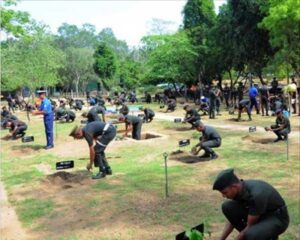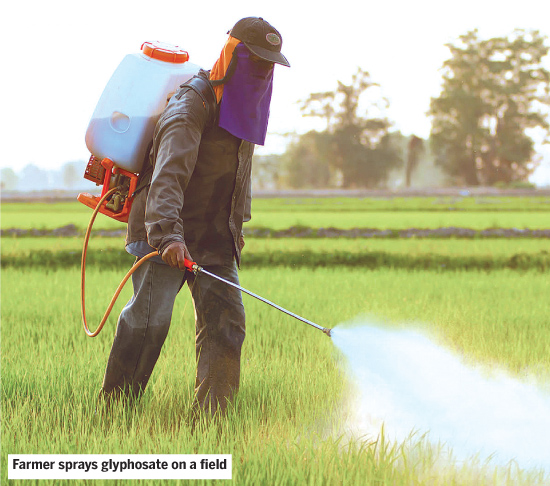
Is the herbicide Glyphosate safe?
It was reported in recent issues of several local newspapers that a four-member cabinet subcommittee has been appointed to study a cabinet paper that seeks permission for a limited use of glyphosate (often known by its original brand name, Roundup) in the plantation sector. The cabinet paper apparently had been submitted on the basis of a report by a committee appointed to make recommendations with regards to the pesticide and insecticide policy to the ministerial committee on economic management. This review of the decision is to reconsider the existing ban on glyphosate, a widely used chemical weedicide, to boost dwindling tea crops by cost-effective removal of overgrowing weeds in tea lands.
The request by the plantation management to control weeds in their tea plantations ‘efficiently’ by chemical means, as had been done in the past before the ban, in order to resuscitate the dwindling tea industry, particularly in the mountainous watershed areas of the country, is understandable from their short-term economic perspective. However, at a time when the Government is committed to sustainable development, in which the costs of the overall negative impacts of health aspects all-round (using internationally accepted precautionary principle in the absence of concrete evidence, as yet) also need to be given its due consideration in an era of moving towards an all inclusive Sustainable Development and Green Economy in the longer term.
Rethinking tea 150 years on
 Perhaps, this may be an ideal juncture, at a time the Sri Lankan tea industry is celebrating its 150 years of existence, to re-examine their economic development strategies in the light of the impact of their current plantation management systems on ecosystem services such as soil and water conservation, nutrient cycling and maintenance of soil fertility etc. and also their commitment to sustainable eco-friendly agricultural development. If these eco-friendly measures are taken into consideration by the tea plantation industry, it will help to get premium prices with lesser amount of lands used for tea and using lesser amount of labour which is already an issue in the plantations. With respect to cash crop agriculture as a whole, there needs a complete revamp of the present day agricultural and tree crop cultivation systems, particularly in our mountainous watershed areas.
Perhaps, this may be an ideal juncture, at a time the Sri Lankan tea industry is celebrating its 150 years of existence, to re-examine their economic development strategies in the light of the impact of their current plantation management systems on ecosystem services such as soil and water conservation, nutrient cycling and maintenance of soil fertility etc. and also their commitment to sustainable eco-friendly agricultural development. If these eco-friendly measures are taken into consideration by the tea plantation industry, it will help to get premium prices with lesser amount of lands used for tea and using lesser amount of labour which is already an issue in the plantations. With respect to cash crop agriculture as a whole, there needs a complete revamp of the present day agricultural and tree crop cultivation systems, particularly in our mountainous watershed areas.
On the other hand, it is also a national obligation of the Sri Lankan scientific community to monitor long-term impacts of the current land use pattern that requires continuous use of chemical weedicides, pesticides and insecticides in tea, vegetable and other commercial crop cultivations in the watershed areas.
Coming back to the issue of revision of the current ban on Glyphosate, a number of scientific reports are emerging in the international literature both for and against its use in controlling weeds which the ministerial subcommittee and/or their advisors should be looking at before making their decision with far reaching impact.
How safe is glyphosate?
One of such excellent appraisals of recent origin is from two scientists, Dr. Vijay Paul and Dr. Rakesh Pandey from the Indian Agricultural Research Institute who have made an exhaustive review of the literature available on the safety of glyphosate – [N-(phosphonomethyl) glycine] in the journal, Current Science Volume 112, No. 1, January 10, 2017 (Journal Impact Factor 0.843 in 2016/17). This article may be downloaded from the web to get scientific details (http://www.currentscience.ac.in/Volumes/112/01/0011.pdf) some of which I wish to highlight for the general readership.
Glyphosate is one of the most common and largest selling herbicides worldwide, having first registered in the US in 1974. It is a water-soluble, systemic (absorbed through leaves and also roots) and broad spectrum (non-selective) herbicide. It inhibits the biosynthesis of several amino acids by blocking an enzyme in these amino acid biosynthetic pathway in plants as well as in microorganisms (that include beneficial bacteria in the human gut and those in the soils that contribute to maintain soil fertility), but not in animals including humans.
 The aforesaid Indian article quotes several international scientific publications which report that continuous and long-term exposure to glyphosate is responsible for a multitude of modern human diseases, including gastrointestinal disorders, obesity, diabetes, heart disease, depression, autism, chronic obstructive pulmonary disease (COPD), pulmonary edema, adrenal insufficiency, hypothyroidism, infertility, cancer, Alzheimer’s disease, amyotrophic lateral sclerosis (ALS), Parkinson’s disease, prion diseases, lupus, non-Hodgkin’s lymphoma, neural tube defects, hypertension, glaucoma, osteoporosis, fatty liver disease and kidney failure, celiac disease and gluten intolerance.
The aforesaid Indian article quotes several international scientific publications which report that continuous and long-term exposure to glyphosate is responsible for a multitude of modern human diseases, including gastrointestinal disorders, obesity, diabetes, heart disease, depression, autism, chronic obstructive pulmonary disease (COPD), pulmonary edema, adrenal insufficiency, hypothyroidism, infertility, cancer, Alzheimer’s disease, amyotrophic lateral sclerosis (ALS), Parkinson’s disease, prion diseases, lupus, non-Hodgkin’s lymphoma, neural tube defects, hypertension, glaucoma, osteoporosis, fatty liver disease and kidney failure, celiac disease and gluten intolerance.
Another recently reported adverse impact of glyphosate is severe depletion of serum Mn and disruption of bile acid homeostasis and in this way glyphosate can promote autism, Alzheimer’s disease, Parkinson’s disease, anxiety disorder, osteoporosis, inflammatory bowel disease, renal lithiasis, osteomalacia, cholestasis, thyroid dysfunction and infertility. It further states that all the above conditions can be substantially explained on the basis of defective regulation of Mn utilization in the body due to glyphosate.
Additionally, glyphosate contamination has contributed towards the increase in chronic and acute kidney failure, pancreatitis, different types of cancers, various disorders, especially to newborns, not only in humans, but in animals as well. A study published in 2013 reports that the incidences of above diseases/conditions are also rising in many countries with the rise in the use of glyphosate on core/edible crops. Having used glyphosate world over for several decades, its possible health impacts are becoming increasingly evident in scientific literature.
On the basis of these increasing scientific evidence, the World Health Organization’s International Agency for Research on Cancer (IARC) classified glyphosate as a ‘probable carcinogen’ in 2016. However, a later statement issued by the experts from the U.N.’s Food and Agricultural Association (FAO) and World Health Organization (WHO) completely overturned their earlier decision and stated that glyphosate is unlikely to pose a carcinogenic risk to humans. The European Chemicals Agency in early 2017 has given an all-clear certificate, concluding that it is not linked to heightened risk of cancer in people.
This debate on the safety of glyphosate continues to rage as to whether it is associated with a heightened risk of cancer or whether it has the potential to disrupt hormone function and other associated disorders. Some researchers claim that the safety standards used to evaluate glyphosate in the US were prepared more than 30 years ago and based on out- of-date science and may not be able to address the full complement of potential hazards associated with long-term exposure to these chemicals which are now surfacing worldwide. Consequently, these safety standards need urgent review as they may be failing to protect public and environmental health, these researchers claim.
There are several other important issues that have not been adequately addressed by both groups of scientists. One such issue is the use of so called ‘inert ingredients’ that are mixed with glyphosate – the active ingredient- in the preparation of the weedicide mixtures for commercial purposes. These may be even more potent and more harmful than the active ingredient -glyphosate. However, these mixtures being regarded as commercially sensitive formulations by the manufacturers and are therefore, not available for public scrutiny. As such, their chemical composition is not appearing on the label of the product package, according to expert scientists. Consequently, proper scientific investigations should examine the effects of these commercial formulations, as well.
Glyphosate resistant weeds
One of the more serious ecological consequences emerging from the repeated use of glyphosate (or any pesticide, herbicide or insecticide, for that matter) over a long period of time is the development of glyphosate resistant weeds. At least 15 species of weeds have developed resistance to glyphosate in the U.S., and resistant weeds are spreading around the world, according to the International Survey of Herbicide Resistant Weeds. Once an important weed-control tool, glyphosate is now unreliable, even for farmers who have never planted genetically modified crops.
Please see the following reference for more details: http://cen.acs.org/articles/93/i37/Rocky-Road-Roundup.html
This international debate will, no doubt, continue to protract for decades (as in the case of cigarette smoking and cancer debate) due to confrontational approaches taken by vested interests as seen in the readers ‘comments on articles on the web. But the Sri Lankan scientific community following the Indian initiative mentioned above, should avoid getting entangled in these verbal diatribes and instead should accelerate long-term interdisciplinary studies already initiated on the health and environmental impacts of improper use of agrochemicals in our own agro-ecosystems, particularly those in the watershed areas. In this regard, an interdisciplinary study of land use (or mis-use) patterns in a the upper reaches of a river basin or in a sub-basin, at least, and an economic valuation of the ecosystem services they offer (or they deny) may be in line with our compliance with the Sustainable Development Goals (SDGs), in particular, the SDG Target 15.3 which states that ‘by 2020, integrate ecosystem and biodiversity values into national and local planning, development processes, poverty reduction strategies and accounts’. As a necessary extension, such studies currently being done in traditional lowland cascade (Ellangawa) systems need to be expanded further.
Such projects not being of ‘mega-scale’ may not appeal to most politicians and as such, would not get the priority green light for implementation although we are committed to a green economy in this ‘Blue-Green Era’.
However, robust science coupled with traditional wisdom continued over many generations with a proven history of ‘starting small and ending big’ rather than the other way around would no doubt, prevail at the end, in this era of sustainable development.
We hope that the ministerial subcommittee would not only look at this problem in a short-term sectoral development perspective, but in a holistic manner in accordance with the national obligations to international agreements safeguarding health of humans and the environment of this island nation already burdened with many a man-made cataclysms.
(The writer is Professor Emeritus at the Peradeniya University)
Source – 26/07/2017, Daily News , see more at – http://www.dailynews.lk/2017/07/26/features/123193/herbicide-glyphosate-safe
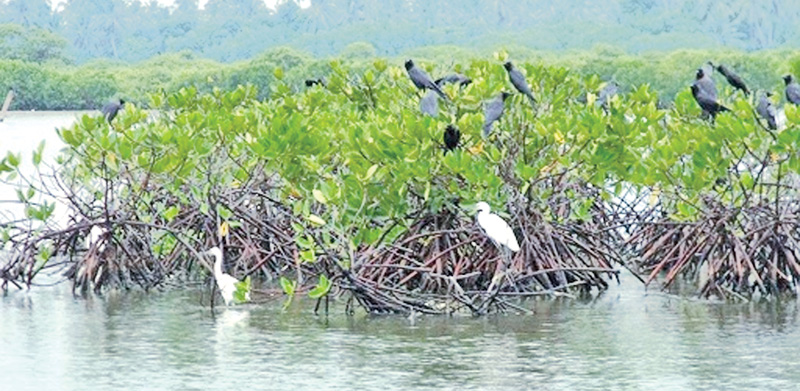
Supreme Court stays garbage dumping at Muthurajawela till August 3
The Supreme Court today further extended its Interim Order till August 3, preventing authorities including the Colombo Municipal Council (CMC) from dumping garbage in the Muthurajawela Sanctuary.
Three-judge-bench comprising Chief Justice Priyasath Dep, Justice Anil Goonaratne and Justice Nalin Perera made this order pursuant to a fundamental rights petition filed by 35 five residents in the close proximity of the Muthurajawela Sanctuary seeking an Interim Order directing the authorities not to store or dump garbage in the Sanctuary.
Additional Solicitor General Sanjay Rajaratnam appearing for the respondents had informed Court that the CMC was not disposing garbage at the Muthurajawela Sanctuary.
The petitioners cited Colombo Municipal Council (CMC), CMC Municipal Commissioner, Urban Development Authority (UDA), Central Environment Authority (CEA), the Wattala Pradeshiya Sabha and six other parties as respondents.
The petitioners further stated that the petitioners and their families and other residents of the close proximity of Muthurajawela Sanctuary have been severely affected and continue to be affected by this dumping.
The petitioners further stated that the area in question is declared a sanctuary under the Flora and Fauna Protection Act by the gazette dated 31.10.1996 in recognition of its vast bio-diversity.
The petitioners further stated that the Muthurajawela is also a large paddy field and it also consist of water canals, marsh lands and the forest.
As per the register of the Agrarian Development Office of the area shows that the total extent of paddy fields in the Muthurajawela amount to 635 acres and a marsh and mangrove amounts to 7,000 acres, the petitioners added.
The petitioners stated that by the said action of dumping garbage in to the sanctuary without any authority or following property procedures, the authorities who allowed and commit such acts have violated the Laws of the country including Section 33(1) and 34(1) of the Agrarian Development Act No.46 of 2000, Section 7(1) (h) (i), Section 7(1) (c) (ii) of the Flora and Fauna Protection Ordinance.
The said acts done by the CMC have infringed Fundamental Rights of the petitioners as well as of the members of the general public guaranteed to them by them by Article 12(1) and 14(1) (g) and the Fundamental Right to life which is also constituted and guaranteed by the Constitution of the republic.
The petitioners further sought a declaration on the respondents to take necessary actions and appropriate steps to ensure that no garbage is deposited and dumped in the Muthurajawela Sanctuary.
Source – 25/07/2017, Daily News, See more at – http://www.dailynews.lk/2017/07/25/local/123132/supreme-court-stays-garbage-dumping-muthurajawela-till-august-3
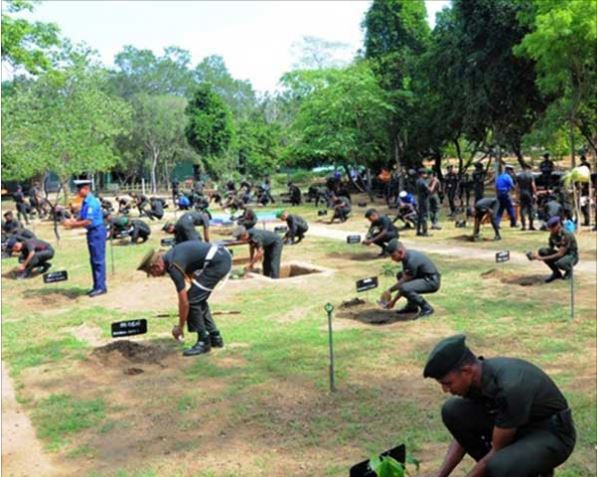
Herbal garden at CTS
All staffers, instructors and trainees at the Combat Training School (CTS), Ampara, together launched a new ‘Osu Uyana’ (Herbal Garden) after planting 100 indigenous species within the premises recently.
The simple planting ceremony took place in the presence of the CTS Commandant, Major General Shantha Dissanayake.
Senior Non-Commissioned Officers (SNCOs) and Non-Commissioned Officers (NCOs) under training in the ongoing ‘Leadership Development Course No 15’ also joined in the planting ceremony. (MT)
Source – 25/07/2017, Ceylon today, See more at – http://www.ceylontoday.lk/article20170401CT20170930.php?id=5794
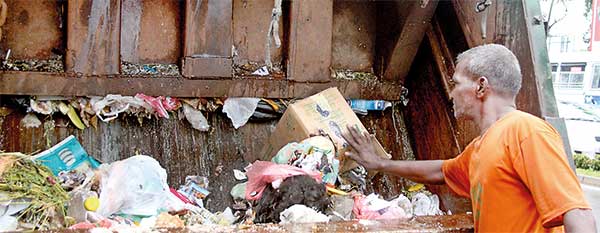
Garbage to Produce 30MW power

By Niranjala Ariyawansha
The Ministry of Megapolis and Western Development yesterday said that tenders have been awarded to three companies to construct three small power plants with a combined 30 MW capacity in the Western Province using waste for energy generation.
Secretary to the Ministry Nihal Rupasinghe told Ceylon Today that they hope that work on these small power plants will commence within the next two months. He added that it will be possible to add the 30MW from these three power plants, to the national grid within the next two years.
These power plants will be located in Colombo, Gampaha and Karadiyana. Tenders for construction have been awarded to a German, Korean and Sri Lankan company respectively.
Rupasinghe said “We will make arrangements to produce 10MW at each of the three power plants.
“All engineering and logistics work in connection with all three power plants have been completed and the three companies which will be constructing the three power plants have now begun working towards obtaining the Environmental Impact Assessment (EIA) from the Central Environmental Authority.”
These three power plants have an installed capacity of producing energy from 1,500 tons of garbage.
Another objective in constructing these plants is to use as a solution for the waste problem that’s mounting in the Western Province.
Source – 22/07/2017, Ceylon today , See more at – http://www.ceylontoday.lk/article20170401CT20170930.php?id=5761
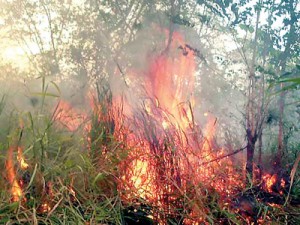
Forest fires, deliberate in some cases, finish off native plants
The Nilgala herbal forest in the Monaragala District from where medicinal plants are obtained for Ayurvedic treatments was among several areas from where wildfires were reported this week.
Forest fires, mostly in parts of the Baddulla and Monaragala Districts destroyed plants and animals as well as endemic and rare plants.
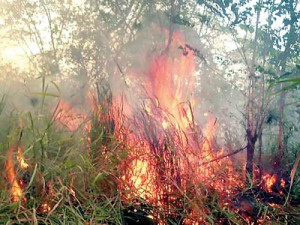
Forest fires destroy endemic and rare plants. Pic by Sumanasiri Gunathilake
Adviser of the Uva Provincial Department of Ayurveda, Piyal Marasinghe, said highly valued medicinal plants could become extinct if such wildfires caused by humans continued.
“Although large medicinal trees such as Bulu, Nelli and Aralu survive these fires, rare herbal plants like Vanaraja, Kadulessa, Bin Kohomba suffer significant damage during July and August when forest fires are more common,” he said.
He said herbs such as Bin Kohomba which are effective in treating viral flu and threatened species including Duhudu have been destroyed in forest fires reported in the Nilgala forest.
According to a report by the Forest Department last year, fires had damaged more than 2,300 hectares (5,683 acres) of forest cover. This year, Monaragala and Badulla were the worst affected. Last year, 469.9 hectares (1,161 acres) and 229 hectares (565 acres) of forest cover was affected in Badulla and in Monaragala districts respectively.
This year, an estimated 161 ha (400 acres) have been destroyed in forest fires in the Monaragala District.
Districts such as Matale and Kandy which were severely affected by forest fires last year with about 257.8 ha (637 acres) and 240.3 Ha (593 acres) respectively, they have not yet been significantly affected this month. However, district officials predict more fires, especially during August.
A few other incidents were also reported at the beginning of this month in Anuradhapura District.
A H Ravindra Kumara, assistant director of the disaster management unit, Monaragala District, said the dry spell is the major reason for the rapid spread of the fires.
At the time we were speaking to him on Thursday evening, he said out of the four forest fires reported on Wednesday, two had been doused with the assistance of the area residents, forest conservation officials and the army while the other two in Kotabowa shrub jungle and Kumbukkana Kalawalaragama reserve had not been doused.
Please turn to Page 13
Mr Kumara said some fires are set deliberately, while there also are instances of negligence.
“Poachers set fire to forests to trap animals. One trick is to set fire from one side and wait at the other side to catch them, or sometimes they catch the animals that come to eat the tender grass that grow after a fire,” he said. He added that there were also instances when people set fire to illegally grab land that belongs to reserves and forests.
Sand miners are another group largely responsible for fires on slopes and hilly areas, Mr Kumara said. He said that when vegetation on slopes are set alight in the dry season by sand miners, the sand washes off to the rivers in the rainy season. “This allows the miners to extract more sand from river beds,” he explained.
Illegal cannabis growers also often set fire to grasslands. Then they grow cannabis plants which are concealed amid tall grasses such as mana.
According to him, forest fires are common in Obbegoda, Kumbukgoda, Buththala and Wellawaya.
E M L Udaya Kumara, assistant director of Badulla District Disaster Management Coordination Unit said about five forest fires are reported to him every day.
He said forest fires are common in Hali Ela, Ella, Bandarawela, Koranathota, Meegahakiul, and Lunuwela areas.
Hali Ela Divisional Secretary in Badulla said more than 32 ha of forests had been destroyed in the Hali Ela divisional secretariat alone this month while many small patana areas too, had been affected due to fires.
Mr Kumara said illegal loggers and game hunters are setting fires along with livestock owners who try to clear the land to regenerate grass for their herds. But there are also arsonists seeking cheap thrills.
“Usually those who intentionally set fires do so in the evenings or at the night especially on Saturdays and Sundays,’’ he said.
He said water catchment areas, commercial plantations, forest plantations and even business ventures, schools, water lines suffer damage.
Environmentalists claim that all fires are caused by Sri Lankans.Supun Lahiru Prakash, president of the Biodiversity Conservation and Research Circle, said forest fires destroy many endemic species. “We have found monkeys, loris and pangolin trapped in fires,” he said.
One adverse outcome is the spread of invasive species when native species are destroyed in fires.
Mr Prakash said the destruction alters the climate and the hydrological cycle.
He said the capacity of rivers is also reduced when silt builds up due soil erosion. Agricultural lands are damaged as well.
Meanwhile, Nanda Kumara, conservator of forests, protection and law enforcement of the Forest Department, said efforts are underway to reduce forest fires.
They include awareness programmes among the public and school children, forest restoration, deploying watchmen and creating fire belts. In some forests, a 22 foot wide portion has been removed to prevent fires from burning deep into the interior areas.
Source – 23/07/2017, The Sunday Times, See more at – http://www.sundaytimes.lk/170723/news/forest-fires-deliberate-in-some-cases-finish-off-native-plants-251519.html
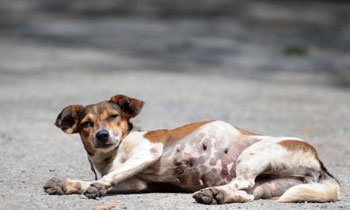
Police begin probe on Moratuwa Uni’s animal ‘killing’
Police have launched an investigation following a charge by animal rights activists that stray dogs and cats had been eliminated at the Moratuwa University last Friday. Vice Chancellor Ananda Jayawardene said police recorded his statement and statements from security personal of the University.
“The university did not encourage the killing of dogs but only wanted the dogs removed from the lecture halls, canteens and laboratories as they were a nuisance,” he said. He said he was not aware that the security personnel had used sedatives on the animals when they were instructed only to remove the animals in a humane manner. “Last Saturday I got to know that the dogs had been injected sedatives and two had died in the process,” he said.
An animal rights activist and founder of Ray of Hope, Iraki Lankika Koddituwakku said that security personnel had no expertise regarding the removal of strays and that they had committed a sinful act by injecting Ketamine to 20 dogs and cats . Another activist Wiboda Abegoda said they have lodged complaints at the Moratuwa and Homagama police stations to take action against those responsible for the killings.
Meanwhile, lawyer and animal rights activist Lalani Perera called for repeal of the 1907 Prevention of Cruelty to Animals Ordinance and the introduction of fresh legislation, pointing out that under the existing law, the crime of cruelty to animals carried a meagre fine of Rs. 100.
Source – 23/07/2017,The Sunday times, See more at – http://www.sundaytimes.lk/170723/news/police-begin-probe-on-moratuwa-unis-animal-killing-251697.html
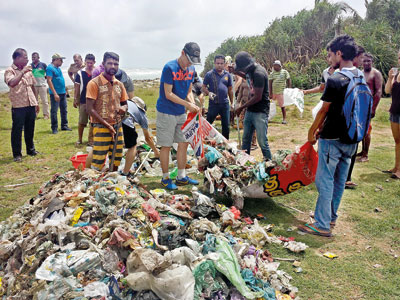
Joining hands to eradicate dengue
Government, villagers and non-government organizations have launched a multiplicity of programmes aimed at clearing garbage in an effort to minimise the spread of dengue.
Last week a group of foreign university students visiting the country joined hands with locals to clean up a stretch of beach in Moratuwa.
The foreign students, together with students from the Moratuwa University and workers from the Moratuwa Municipal Council joined hands to clean up a 500-metre stretch of sea shore.
Students from a host of countries, comprising students from China, Sweden, South Korea, Germany, Belgium, France and Turkey participated in the cleanup effort.
The campaign revealed a number of breeding sites of the dengue mosquito which were destroyed.
Plastic bottles, polythene bags and other recyclable materials were collected separately and sent for recycling.
Story and pix by Reka Tharangani Fonseka
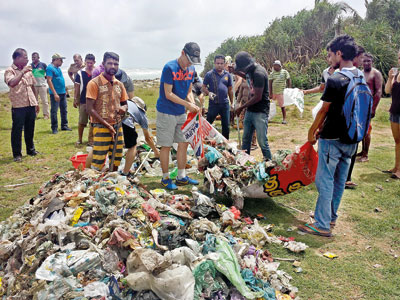
Foreign university students joined in clearing a 500- metre stretch of beach at Moratuwa
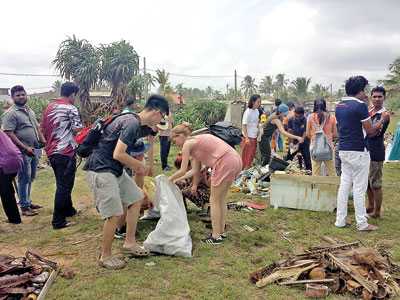
Can we be civic-minded enough to ensure our beaches are not polluted after the clean up
Source – 23/07/2017 , The Sunday Times, see more at – http://www.sundaytimes.lk/170723/news/joining-hands-to-eradicate-dengue-251474.html
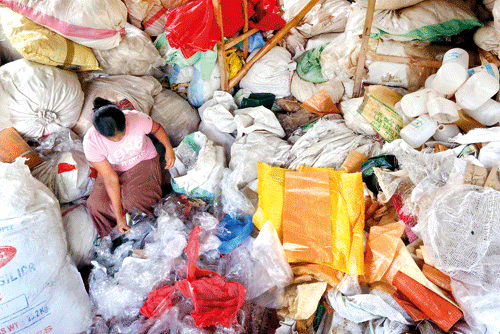
Think plastic, think creative
A recycling and upcycling plant in Katana is lending a hand to save our planet one plastic bag at a time
Where others see waste they see potential.
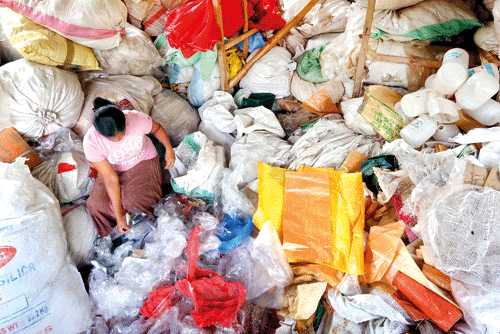
Recycling: Sorting out the plastic (top) and (right). Pix by M.A. Pushpa Kumara
At the unassuming property that is No. 102/1 West Kaluwarippuwa Road, Katana, you will find a plastic recycling and upcycling plant that is serving the community of Katana. Co-owned by Jayantha Kumarasiri and Akvan Gajanayake, the operation is run by Jayantha who decides how best to use the material he obtains. Gunny bags and old curtains are used to make beautiful files which he feels would probably last twice as long as the standard plastic files Sri Lankans use.
Jayantha started working at a plastic manufacturing plant, after school and higher studies learning a great deal about manufacturing polythene. He learnt the process of injection moulding plastic at another factory before learning of the recycling process. Becoming factory manager of a recycling plant later on, he saw that they used plastic imported from Saudi Arabia to be recycled. “I thought then we can use our own plastic,” he says. He then started collecting plastic on his own and sending it to recycling plants. While working as a manager at a factory in Galle, he met Akvan through the Environmental Foundation (where Akvan was working at the time) and later, after purchasing the equipment from a recycling plant which was being shut down, they opened their own plant.
Today, the plant produces recycled plastic pellets and has recently started producing upcycled products. “The upcycling process is very creative and the team designs different things daily,” Jayantha says.
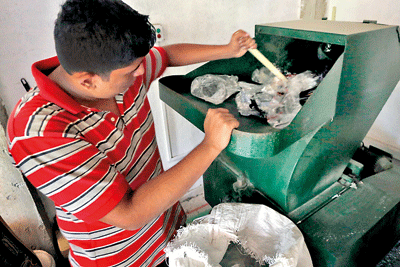 The recycling process is long. First the plastic which is collected (from corporations and households at a fee) is sorted according to density. Then it is crushed into rough pieces a few millimetres long using a shredder. Next it is sent through a compactor which transforms it into lumps. The lumps are crushed again to reduce the size and sent through an extruder which converts it into strings of plastic which look like an endless plastic rope. This rope is finally sent through a pelletizer and the final plastic pellets are sold.
The recycling process is long. First the plastic which is collected (from corporations and households at a fee) is sorted according to density. Then it is crushed into rough pieces a few millimetres long using a shredder. Next it is sent through a compactor which transforms it into lumps. The lumps are crushed again to reduce the size and sent through an extruder which converts it into strings of plastic which look like an endless plastic rope. This rope is finally sent through a pelletizer and the final plastic pellets are sold.
While they used to be sold for a reasonable price, Jayantha tells us that now prices have gone down. “Plastic is a by-product of petroleum. This means that when the petrol prices increase, the price of our pellets also increases. We used to sell them for good prices. Now the plastic price has gone down because the price of petroleum has reduced,” he notes. The price of virgin plastic pellets is directly affected by the price of petroleum which in turn affects the price of recycled plastic pellets. What saddens him is the fact that they cannot manufacture a final product from plastic pellets because of the lack of machinery, something he hopes he will to do in the future. He also hopes to set up a plastic research and development centre in the future. Jayantha is grateful to Akvan for all the help he has received. “Akvan has helped me with this project a lot and I am thankful that he is there with me on this project” he says.
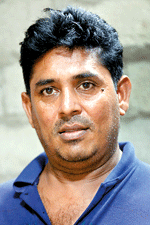
Jayantha Kumarasiri
Helping Jayantha recycle plastic are villagers from the area. Dilrukshika Niroshani, 36, lives ten minutes away and with two children aged 16 and 8, she finds this job very convenient. “We can tell Jayantha Aiya and leave early or take a day off if we need to attend to our children, and we get paid according to what we sort so it’s easy for us,” she says. T.P.G. Pushpa, 52, who has been there from the inception, also has the convenience of living close by. They have both stopped burning plastic at home – a harmful practice they used to engage in before they started working at the plant. Now they bring the plastic to be recycled and have educated their children on the harmful effects of plastic. “They are the experts at sorting– they know what to do and exactly how we want it,” says Jayantha. They also help with the upcycling process – transforming waste into beautiful products.
Upcycling is the process of taking discarded plastic and converting it into better quality products which can be reused. A much simpler process than recycling, this project is a collaboration of the Universities of Western Australia, Moratuwa, Sri Jayewardenepura and Jaffna alongside the Australian organisation Waste for Life. The University of Western Australia taught Jayantha and the Lankan universities how to upcycle and the machinery required was also given through this collaboration. “Without any expectations they (the University of Western Australia) spent their own money and let us use their patents and helped us so much,” he says, adding that they even trained the workers.
“We were taught to use the plastic outside and the fabric inside, but as the quality of the plastic is sometimes not that good we had discolouration of the files occasionally, so we tried keeping the plastic inside which was much more successful,” Jayantha says. Always ready to innovate, he is now looking into making covers for electronic devices such as laptops and tablets and purses for weddings etc.


Upcycling: Some of the creative products made at the plant
Jayantha, Dilrukshi and Pushpa all agree that people need to be more educated about the harmful effects of plastic. “We can produce much more recycled plastic if people would give us more plastic,” he says. Though they see the plastic recycling plant, people still throw plastic on the road, which shows their lack of discipline, Dilrukshi feels. “Api gewala ganna hinda apita dunna nam hondai (because we pay and take it if people gave it to us, that would be great),” Pushpa adds. There is a lack of understanding, Jayantha says, “sometimes people give us plastic with remnants of food and we cannot use them because cleaning that is not profitable.”
“This factory will be a good opportunity for Municipal Councils in the Gampaha district to give their waste polythene to be recycled, especially since garbage disposal has become a big problem,” Akvan says.
Walk out of No. 102/1 West Kaluwarippuwa Road, Katana and instead of the plain grey walls, your mind’s eye will see the potential it holds – the waste it takes in and turns into something quite beautiful – helping save the planet one plastic bag at a time.
Source – 23/07/2017, The Sunday Times, See more at – http://www.sundaytimes.lk/170723/plus/think-plastic-think-creative-251191.html
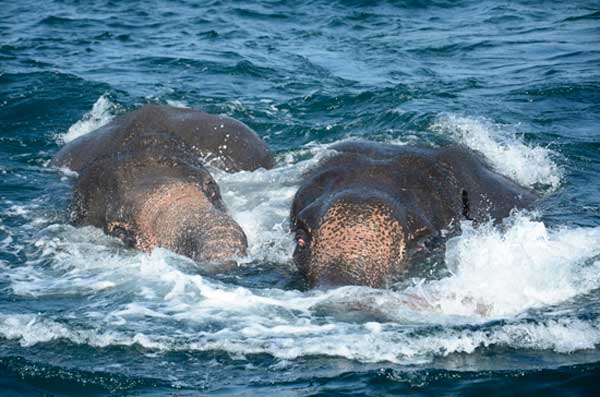
Navy rescues 2 more jumbos from sea
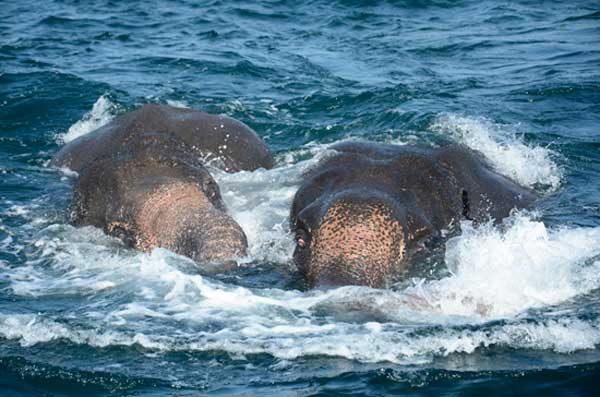
A group of naval personnel attached to the Eastern Naval Command had rescued two elephants that were swept out to the sea, in between Round Island and Foul Point, Trincomalee this morning.
Source – 23/07/2017, DailyMirror, see mora at – http://www.dailymirror.lk/article/Navy-rescues-more-jumbos-from-sea-133322.html
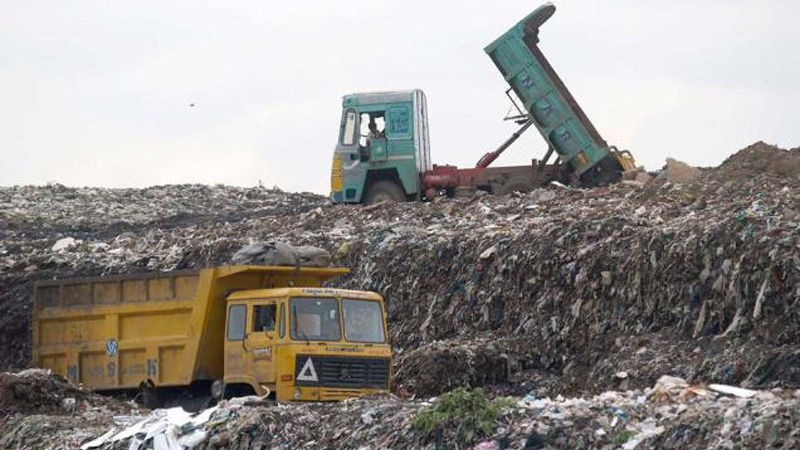
Sri Lanka moves to generate electricity from garbage
The government is set to initiate three projects in the Western Province next month to generate electricity using municipal solid waste.
The initiative forms the basis of measures to find a permanent solution to the festering garbage crisis in urban areas.
President Maithiripala Sirisena and Prime Minister Ranil Wickremesinghe spearheaded the move to find permanent solutions to the existing issue surrounding garbage.
As a result, President Sirisena appointed a three member task force, headed by Ministers Champika Ranawaka, Faiszer Musthapha and Western Province Chief Minister Isura Devapriya to pilot the project in the Western Province and specifically Colombo.
“With international support, with the use of latest technology, we will solve this crisis so that it will no longer a problem for any future leader or a government.
“Today, we see protests, but no one offers solutions…,” President Sirisena said at a function held during the weekend.
He added that he was monitoring progress every two weeks of a committee to deal with the problem of garbage disposal. No previous government had given such priority to this issue,” he said.
Prime Minister Wickremesinghe who addressed UNP officials who helped his political career which began from the Biyagama electorate 40 years ago, spoke of the waste disposal crisis and the government’s initiative to resolve it.
Megapolis and Western Development Minister Patali Champika Ranawaka said the government has found permanent solutions to the piling garbage crisis that remained unresolved by successive governments for decades.
“We will start three projects next month in the Western Province to generate electricity using garbage,”the minister said while launching a 30-million rupee railway square in Ella over the weekend.
He said the previous administration boasted that it deployed the army and did not allow even a toffee wrapper to be dropped in the city of Colombo. However, the reality was that they haphazardly dumped garbage at Meethotamulla leading to the April tragedy when nearly 40 people died after a mountain of rubbish collapsed on them.
The minister said unlike the previous government, the new administration did not deploy troops to clear the garbage that had piled up in the city, but the municipal sanitary workers had been used for the job.
“We no longer pile up garbage. Out of the 700 tonnes of garbage generated in Colombo, 300 tonnes are being turned into compost. Another 100 tonnes is being recycled.
“We are going to improve this even further. To permanently solve the garbage crisis in the country, we are building a sanitary landfill in Aruwakkalu (in Puttalam district),” the minister said.
http://www.dailynews.lk/2017/07/24/local/122947/sri-lanka-moves-generate-electricity-garbage



